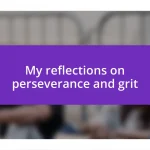Key takeaways:
- Fair assessments promote equity by accommodating diverse learning styles and creating a level playing field, enhancing student engagement and confidence.
- Effective assessment design involves clarity, inclusivity, flexibility, and continuous feedback, empowering students to fully demonstrate their understanding.
- Incorporating student voice in assessments fosters ownership and investment in learning, resulting in more meaningful and collaborative educational experiences.

Understanding fair assessments
Fair assessments are not just about judging performance; they are fundamentally about equity and reflection of true capability. I remember a time when I was part of an assessment committee that struggled to create questions which considered different learning styles. This experience highlighted how easily assessments can overlook diverse strengths, ultimately disadvantaging students.
Have you ever taken an assessment that seemed to favor one group over another? I often think about how important it is to create a level playing field where every learner feels they have the opportunity to shine. Fair assessments should be designed to accommodate varied approaches to learning, acknowledging that not everyone processes information in the same way.
In my view, transparency in the assessment process is crucial. When students understand the criteria and purpose behind an assessment, it not only demystifies the process but also builds trust. I recall discussing a grading rubric with my students, and their insights taught me as much as I taught them about fairness in assessments. It’s these collaborative moments that deepen our understanding of fair assessments—after all, isn’t the goal to foster growth and understanding rather than just to label success and failure?

Importance of fairness in assessments
Fairness in assessments plays a pivotal role in shaping a positive educational experience. I can’t help but recall a time when I was involved in evaluating a group project. The different perspectives each student brought revealed their unique strengths, which initially seemed impossible to compare fairly. This experience underscored the importance of crafting assessments that capture diverse contributions while ensuring that each student’s efforts are recognized equitably.
I often reflect on the impact of unfair assessments on a student’s motivation. In one instance, a student confided in me that they felt their potential was overshadowed by a rigid rubric that didn’t account for innovative thinking. This conversation opened my eyes to how assessments can influence a student’s self-esteem and future engagement. It’s essential that we create assessments that foster not just learning but also confidence in a student’s abilities.
The idea of fairness also extends to the testing environment itself. Picture this: a room filled with stressed students, some grappling with anxiety while others seem at ease. I once organized a calm, supportive testing atmosphere for an exam, and the difference in student performance was remarkable. Ensuring fairness in assessments means setting the stage where every student feels secure enough to express their knowledge, ultimately leading to a more accurate representation of what they’ve learned.
| Importance of Fairness | Impact of Unfair Assessments |
|---|---|
| Encourages Equity | Creates Anxiety |
| Enhances Student Engagement | Limits Confidence |

Principles of effective assessment design
Principles of effective assessment design
When designing assessments, I firmly believe that clarity and alignment with learning objectives are essential. A few years back, I revamped an assessment strategy for a course where feedback was often vague. By ensuring that each question directly linked back to our learning goals, both students and I had a clearer understanding of expectations, making the feedback process much more productive.
I have found that incorporating flexibility into assessments not only accommodates diverse student needs but also encourages creativity. Here’s a quick look at some key principles that have consistently guided my approach:
- Transparency: Clearly outline criteria and expectations to eliminate confusion.
- Inclusivity: Design assessments that consider different learning styles and backgrounds.
- Flexibility: Allow for various methods of demonstrating understanding and mastery.
- Continuous Feedback: Foster an environment where ongoing feedback helps guide student progress.
- Relevance: Ensure assessments are meaningful and connected to real-world applications.
Reflecting on these principles reinforces my conviction that effective assessments empower every learner, allowing them to shine in their unique ways.

Strategies for equitable assessment practices
One effective strategy for equitable assessment practices is the integration of multiple formats to cater to different strengths. I remember when I introduced a project-based assessment alongside traditional testing. This shift allowed students who thrived in hands-on environments to showcase their skills creatively. It made me wonder — how often do we underestimate the potential of non-traditional assessments? By diversifying our assessment formats, we create opportunities for all students to shine.
I’ve also found that providing timely and constructive feedback can significantly level the playing field. In one course, I made it a point to meet with students one-on-one after assessments. This personal touch often revealed their thought processes and struggles that were not evident through grades alone. Isn’t it fascinating how a simple conversation can illuminate a student’s journey? It reinforced my belief that feedback should nurture growth, not just evaluate performance.
Moreover, involving students in the assessment process can enrich their learning experience. I tried a peer-review system once, where students assessed each other’s work before I provided my feedback. The sense of ownership and accountability they felt was incredible. As they shared insights with one another, I witnessed a transformative exchange of ideas and perspectives. This approach not only democratized the assessment process but also built a supportive classroom community. Don’t you think giving students a voice in their evaluation fosters a deeper understanding of their learning?

Tools for assessing student performance
I’ve found that technology can be a game-changer in assessing student performance. For example, when I first integrated online quizzes, I was hesitant, but I soon realized how they provided instant feedback for my students. The excitement on their faces when they saw their results was priceless, and it sparked meaningful discussions about their learning. How often do we consider how immediate responses can motivate students?
Another tool that has worked wonders for me is the use of rubrics. In one of my courses, I created a detailed rubric that highlighted specific expectations for each assignment. Students appreciated having a clear roadmap, and I discovered that it not only reduced their anxiety but also improved the quality of submissions. Isn’t it remarkable how a simple guideline can empower students to excel in their work?
I’ve also experimented with reflective journals as a form of assessment. Initially, I wasn’t sure if they would resonate with my students, but they quickly became a favorite. Watching them articulate their learning journeys and challenges helped me understand their perspectives better. It reminded me of the importance of encouraging self-reflection—after all, isn’t it through reflection that we truly learn?

Feedback methods for continuous improvement
One feedback method I’ve found invaluable is the use of exit tickets. At the end of a class, I would ask students to write a brief reflection on what they learned and any lingering questions they had. This practice not only lets me gauge their understanding but also opens up avenues for personalized follow-up discussions. It made me realize just how much students value having their voices heard, even in just a few sentences.
Another approach I’ve embraced is feedback loops, where I continuously invite student input on their assessments. One time, I asked for suggestions on how to improve a midterm assignment. The students provided such insightful feedback that I was genuinely surprised. They felt a sense of ownership over their learning, and I could see how their engagement soared. Was I truly tapping into their preferences before that? This back-and-forth not only enriches my teaching strategies but helps refine their learning experience as well.
Recently, I started utilizing audio feedback on assignments—a method that has truly resonated with me and my students. I remember a moment when a student told me that hearing my voice made my feedback more personal and less intimidating. This human touch enhances the dialogue and makes them feel connected to their progress. Doesn’t it make sense that a little warmth in our communication can foster a deeper understanding of one’s performance?

Incorporating student voice in assessments
One of the most rewarding experiences I’ve had with assessments is when I consciously invited my students to contribute their thoughts on what assessments should look like. During a brainstorming session, one student suggested an open-choice project that resonated with many classmates. The energy in the room was palpable. It was more than just a brainstorming session; it felt like we were co-creating their learning journey together. I realized that when students have a voice in shaping their assessments, they are more invested in the outcomes. Don’t you think that this sense of ownership could truly elevate their learning experience?
Incorporating student voice doesn’t always require formal changes. I remember one day, I simply asked my students to rate different assignment types we’d done throughout the semester. Their candid feedback revealed preferences I hadn’t anticipated—some preferred group work while others thrived on individual projects. This small change—it felt like a gentle nudge—allowed me to adjust my approach in real-time. By respecting their perspectives, I’ve seen a notable increase in participation and enthusiasm during assessments. Isn’t it fascinating how attention to student preferences can lead to such a positive shift in energy?
Moreover, I’ve experimented with creating student-led assessments, where they design a part of the evaluation criteria. I recall one student proposing a peer-assessment component that allowed classmates to give constructive feedback on each other’s work. Initially, I was unsure how it would play out, but it turned out to be an empowering experience for all involved. The students took their roles seriously, and I could see their confidence grow as they articulated their thoughts. Isn’t it amazing how giving students a voice can spark their growth in ways we often overlook?














